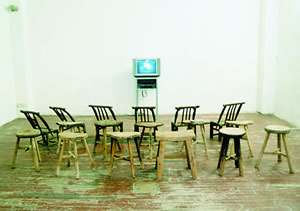 AS the taxi drove along Xisuzhou Lu, this writer was sorry to find the red house that used to host Eastlink Gallery and several artists' studios had already been demolished.
AS the taxi drove along Xisuzhou Lu, this writer was sorry to find the red house that used to host Eastlink Gallery and several artists' studios had already been demolished.
After turning onto Moganshan Lu, the taxi stopped at the gate of an industrial park. Moving out of No. 1133 Xisuzhou Lu, Eastlink, ShanghART, and some artists had found their new homes in this nearby quarter.
It was the opening of Eastlink's first new year and new location exhibition.
After entering an antique elevator - the operator warned someone who tried to push the button that "it would get stuck between floors" -we reached Eastlink on the fifth floor.
The new place is larger and very cold because of the lack of air conditioning, making it look pale and empty.
Fifteen artist's works are on exhibition, including paintings, installations and a video piece.
One of the first series are cartoon sketches by Lu Chunsheng entitled "I Almost Believed". They were like illustrations for books, with vivid characters who seemed to have stories behind them.
Wang Xingwei's installation was a lyrical reproduction of hanging clothes, which are common in Shanghai although officially banned along the main streets.
Wang had strung neon lights along bamboo sticks. Some people argued that these hanging clothes were a characteristic of Shanghai and should not be banned. The neon lights added a poetic element to this everyday sight, reminding people of its possible disappearance in the future.
Liu Ding had collected empty capsules from some pharmaceutical factories and strung them along fishing lines. These scattered strings are named by a title Liu found in a novel of the Ming Dynasty (1368-1644), "Fragrant Essence Good For Spring". "It was a porn book, with description about sex between men," Liu said. "I thought it beautiful, and took the name." The blue colour of the capsules connotes the famous pill Viagra.
Beside the long table where wine, beer and coke were placed, was a electric heater, around which visitors gathered.
A small room is separated on the left, where stools were placed for viewers of the video work. Scenes of old buildings were presented, with the frames frequently broken by a red or yellow spot skipping up and down the screen. It was a witty work, but not powerful.
Make one more turn and you enter a new space. In the corridor are oil paintings by Qin Yifeng, and a series of installations called "Boxes of Democracy". These were transparent coffin-shaped boxes, each containing a celebrity - The Goddess of Freedom, Deng Xiaoping, as well as the heroine of some renowned classic revolutionary drama.
On the wall is a huge piece on canvas by Liang Weizhou. A girl stood on a stool, changing a bulb. In the dark shadow at the side of the picture, a man stood, watching. It was a scene from ordinary family life, with a very sentimental atmosphere.
January 25-February 25
5F, Building 6
No. 50 Moganshan Lu
Tel: 6276-9932
(Shanghai Star January 31, 2003)
|

